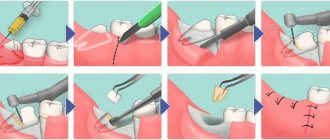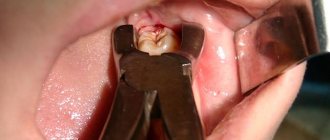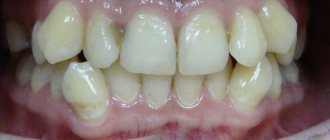What types of pain relief are used during tooth extraction?
A classic example of an archaic tooth extraction without any anesthesia is an episode from Chekhov’s story “Surgery.” In modern dentistry, such outright torture does not happen, and tooth extraction without anesthesia is not carried out under any circumstances. If it is necessary to remove 1 - 2 teeth in one visit, the operation is carried out mainly under local anesthesia. However, there are indications for tooth extraction under general anesthesia.
In medicine, the term “general anesthesia” means a state of inhibition of the central nervous system with a temporary immersion of the patient into sleep of varying degrees of depth and loss of pain sensitivity. This reaction of the body is artificially induced using safe anesthetic medications, and it lasts from 30 minutes to 3 hours, depending on the required volume of surgical intervention. For example, removing 4 wisdom teeth under general anesthesia will require a significant amount of time.
Advantages of tooth extraction under general anesthesia
- Anesthesia slows down the body's reactions, due to which the pain is completely relieved. Therefore, all the dentist’s procedures for removing teeth will be completely painless for you.
- Many sensitive patients put off visiting a surgeon until dangerous complications develop simply because they are afraid of the mere sight of surgical instruments. If teeth are removed under general anesthesia, you will not see how the process will occur, but will only wake up when it is over.
- Even for a psychologically stable person, tooth extraction is a stressful situation that negatively affects the body. For example, patients often experience increased blood pressure during this procedure. However, if the operation is performed under general anesthesia, your nerves will not be damaged.
- While the anesthesia is in effect, the dentist will remove the necessary teeth and perform the necessary manipulations, which could take several visits. He will perform all actions carefully and efficiently, which will reduce the risk of complications.
Interesting fact!
According to data from various media sources, at least 2% of adults and 6 - 8% of children, for various reasons, do not have the opportunity to undergo routine tooth extraction using local anesthesia.
What is medical sedation?
Drug sedation is a unique anesthetic method that allows, first of all, to carry out any treatment in a state of comfort and solve the problem of dental phobia by eliminating old fears with high-quality treatment. Many people believe that drug sedation and general anesthesia are synonymous and are wary of sedation, although they are not the same thing. However, the advantage of sedation, as opposed to general anesthesia, is that drug sedation does not have such a pronounced depressing effect on the body and plunges a person into a state of light, superficial half-sleep.
In this state, the patient can respond to external stimuli, in particular, retains the ability to verbally communicate with the doctor.
- During general anesthesia, “heavy” narcotic drugs are used, there is complete insensitivity to external stimuli, the patient is immersed in a state that is not similar to deep sleep, and the postoperative “aftertaste” of general weakness remains for several days, which requires a hospital stay, and the patient does not remember nothing about what happened.
- When sedation is carried out in a state of light half-sleep, treatment is never accompanied by such a postoperative “recovery” and is perceived completely differently; patients call this state “I slept well and rested,” hospitalization is not needed, these drugs have no toxicity.
Drug sedation without deep immersion during tooth extraction must necessarily be combined with high-quality local anesthesia, since the main goal of sedation in such situations is to eliminate psycho-emotional discomfort, and not painful stimuli.
For drug sedation, different clinics use different drugs; in government institutions or budget clinics, most often barbiturates, benzodiazepine drugs, and nitrous oxide; in high-level clinics, these are propofol-based combinations. The routes of administration of drugs for sedation can be different:
- oral;
- intramuscular;
- intravenous;
- inhalation;
- combined.
!Important: Only a specialist can choose the optimal option for drug sedation; our in-house anesthesiologist will do this, based on the general condition of your body and its individual characteristics. We will choose the best option for you.
Types of anesthesia for tooth extraction and methods of its behavior
Based on the depth of anesthesia, anesthesia is divided into the following types:
- surface;
- easy;
- full;
- super deep.
For dental treatment under anesthesia, only superficial and light anesthesia is used in dentistry. While the last two types are used for complex operations, for example, for maxillofacial injuries.
Anesthesia is carried out in two main ways:
- inhalation - you inhale sprayed particles of the drug through a special mask;
- intravenously - using a regular injection.
High-quality anesthetic drugs promote restful drug-induced sleep and recovery from it without any complications. Modern anesthetic medications are highly safe and suitable even for patients with allergies. They do not cause side effects or addiction and are easily eliminated from the body.
Indications and contraindications
The use of anesthesia in each specific case must have serious medical reasons, so it is used infrequently. In addition, the cost of tooth extraction under general anesthesia is quite high. If you are simply afraid of surgery, but you only need to remove one front tooth, then in this case it is advisable to use light sedatives and carry out tooth extraction under local anesthesia. If the surgeon’s task is much more complex and the volume of work is large, then general anesthesia is appropriate.
Indications
The following main indications exist for the use of general anesthesia during tooth extraction:
- allergy to local anesthetics;
- panic fear of treatment;
- increased blood pressure (hypertension) due to stress;
- a gag reflex in the patient, which prevents the doctor from performing the operation;
- large volume of manipulations;
- inability of a patient with disabilities to sit in the dental chair.
Contraindications
Speaking about contraindications to tooth extraction under general anesthesia, you should be guided by the list of factors presented below that may cause refusal of this procedure:
- exacerbation of chronic pathologies;
- diabetes mellitus in the stage of decompensation;
- acute heart failure;
- period up to six months after myocardial infarction;
- heart defects;
- infectious diseases;
- anemia;
- epilepsy;
- pathologies of the respiratory system.
In what cases should sedation not be performed?
Despite its high safety, sedation, like any medical procedure, has a number of contraindications. This method of pain relief is not recommended for people suffering from drug addiction, withdrawal symptoms, certain pathologies of the nervous system or mental disorders.
Use sedation with caution in patients with a history of brain or spinal cord injuries. Any acute inflammatory processes in the body, as well as severe decompensated diseases of internal organs are contraindications to drug sedation. Before administering anesthesia, the doctor should also check to see if the patient is allergic to the sedation medication.
When is tooth extraction required under anesthesia?
Complex tooth root removal
The lateral (chewing) teeth have a complex root system. Sometimes it takes quite a long time to extract them. Removing a tooth root under anesthesia allows the surgeon to carry out a large amount of work during one patient visit.
Removal of impacted wisdom tooth
One of the most difficult operations is the removal of a wisdom tooth under general anesthesia. The roots of “eights” are often irregular, intertwined with each other, and go under the adjacent tooth. Resection of unerupted (impacted) wisdom teeth is especially difficult. They have to be removed for a long time and carefully through incisions in the gums. That is why 8 teeth are removed under general anesthesia.
Removal of several molars
When it is necessary to remove several molars during one visit to the dentist, it is also advisable to use general anesthesia. Often, the doctor performs additional manipulations of gum plastic surgery with bone grafting if subsequent installation of implants is planned.
Possibility of use in children
Drug sedation is often used in dentistry during tooth extraction in children. This is explained by the fact that children often experience sharply negative emotions when visiting the dentist and cannot sit still while the doctor performs the necessary manipulations. All this calls into question the effectiveness and safety of the treatment, so the issue of drug sedation is being decided.
When removing teeth in children, inhalation sedation can be used as one of the simplest and safest methods. The use of sedation in children allows you to avoid fear of the dentist and accidental injury during tooth extraction.
Stages of tooth extraction under general anesthesia
Preparation
Questions about the choice of anesthetic and the method of its administration are resolved individually for each patient. To do this, the anesthesiologist will collect an anamnesis, inquire about the patient’s chronic diseases and refer him to diagnostic procedures (usually a blood test and an ECG). It is also necessary to consult with a neurologist, therapist and otolaryngologist in order to identify contraindications to the use of general anesthesia.
Operation
Literally one minute after the administration of the anesthetic by inhalation or intravenous route, the patient feels drowsy and gradually falls asleep. Within five minutes, his breathing stabilizes and his muscles relax. During a tooth extraction operation under general anesthesia, a qualified anesthesiologist is constantly with the patient, monitoring his vital signs: pulse, blood pressure, body temperature, skin tone, blood circulation and ventilation.
Coming out of anesthesia
The doctor calculates the dose of the anesthetic so that its effect ends 10 - 20 minutes after completion of all manipulations. The patient gradually wakes up, and after 60 - 90 minutes his state of health is completely stabilized. After this, he can go home, but for this he will need an accompanying person. In addition, after tooth extraction under general anesthesia, you should never drive!
When preparing for tooth extraction under anesthesia, be sure to inform your doctor about all medications you are currently taking. Six hours before surgery you should stop eating and stop smoking. Stop drinking any drinks, including plain water, at least four hours before surgery.










